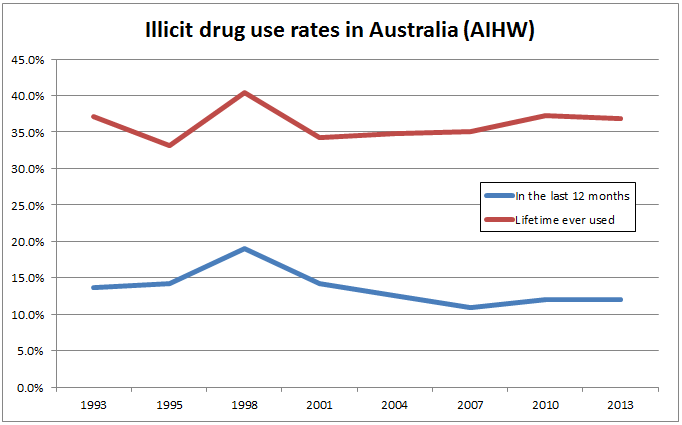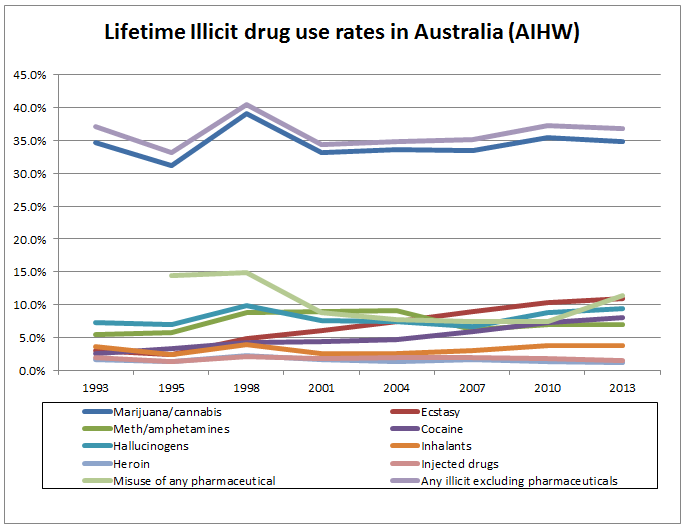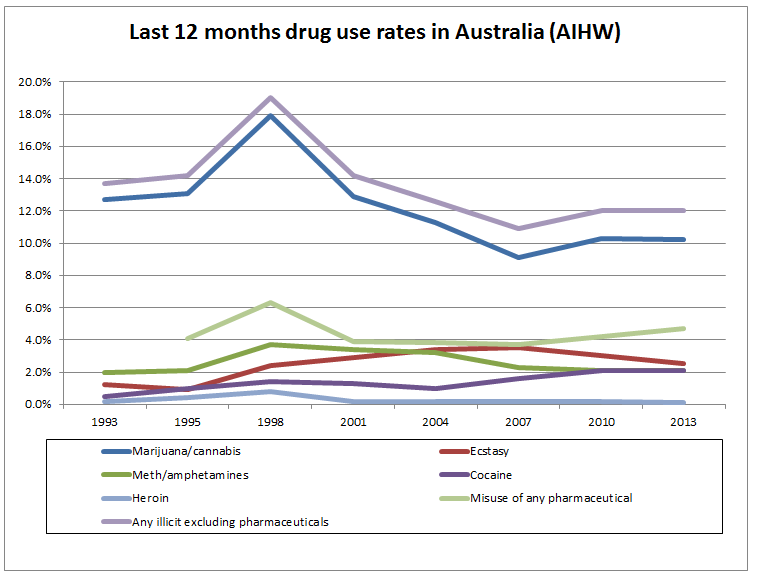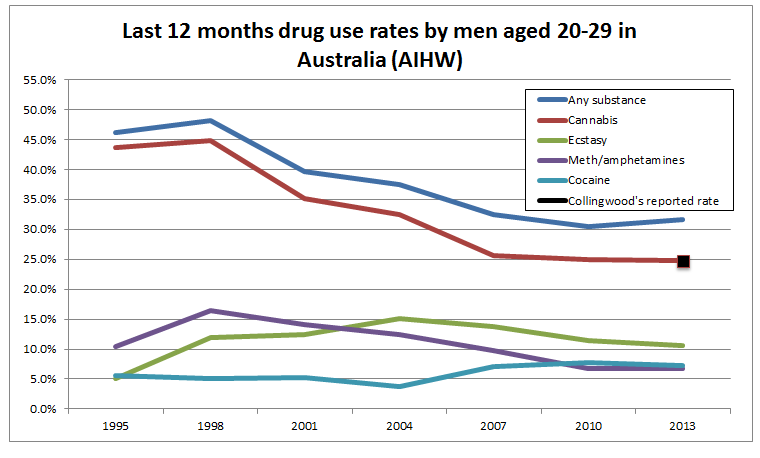This week there has been a lot of lamentable confusion and conjecture around the reporting of the illicit drug positive test rates among AFL players. HPN has also noticed that there hasn’t necessarily been a lot of fact involved in the scrum of opinion. So what are the facts around drug use in Australia, and how it relates to football clubs? Good question, imaginary reader. Primarily, HPN will tackle three commonly raised opinions aired this week:
- drug use is on the rise generally in Australia,
- the reported drug use in football clubs is very high, and
- drug use by AFL players is higher than among other young men.
Background
Hair testing of AFL players in the offseason is a new policy in the AFL, and appears to be a data collection exercise to observe baseline rates of illicit drug use. The testing has been stated to be voluntary and was supported by players through their union (the AFLPA). This information is necessary to have as part of a health-centered drug policy, especially since the AFLPA and AFL appear to want to use the data to help protect and support players’ physical and mental health.
The full expectations of this collection were that it be private, and it’s a shame that it has not been kept that way. The situation harkens back to the acquisition and attempted publication of medical records in 2007 of Hawthorn players relating to drug use by Channel 7.
However, what has been found is that usage by players is probably less than the background rate for their non-football playing young male peers. The headline claim is that 25% of Collingwood’s list (11 of 44), tested positive in hair tests designed to cover their off-season period. This is not is a revelation of anything shameful, exceptional or even particularly dangerous.
Is illicit drug use in society on the rise?
Some of the commentary this week gravely linked these test results to a supposed drug use epidemic in broader society. David King’s comment was an example here, claiming “There is no one in the world that says the use of drugs is on the decline.”
This is an incorrect perception. Use rates for illicit drugs in Australia have likely declined since the late 1990s, but at the very worst remain steady.
First up, a headline grab. A full third of Australians have used illicit substances (or rather, have been willing to report such use to a survey). For this post we’ll be using the Australian Institute of Health and Welfare’s data from the National Drug Strategy Household Survey, which is based on about 20000 respondents.

That fact alone should make us question whether it’s a particularly big deal if a quarter of a football team, on its private downtime in the off-season, is found to have done so too.
It should be noted the bulk of this usage rate is use of Cannabis. If we break down lifetime use by substance it looks like this:

Cannabis almost entirely drives overall reported usage rates, with no other illicit drug having ever been used by much more than 10% of the Australian population. What we observe here is that heroin use and methamphetamine use has dropped in recent years. Hallucinogens and misused pharmaceuticals moved up and down with some volatility. In particular, the numbers who have ever tried cocaine and ecstasy have risen.
However, lifetime use is a slow and lagging indicator since people tend to live for a long time. If we look just at recent use (ie, in the last 12 months) of some of the major drugs, a slightly different picture emerges:

Here we can see ecstasy use actually declining as an ongoing recreational activity after peaking in the 2007 survey. The lifetime rates have still gone up as more people in total have used it, but recent users don’t show that same pattern. Cocaine use here also looks like it may have steadied.
Alleged use by footballers is in line with, or lower, than use by other young men
The tables above all talk about the whole of the population, but young men have the highest use rates for every illicit substance. If we look at use rates for young men specifically, we can see that 32% of men aged 20-29 admitted to using an illicit substance in the last year.
Hair testing should be considered a good measure of total illicit drug use in the AFL. It has something like a three month window of detection and therefore covers an entire off-season. It’s also reasonable to assume that a football team confines pretty much all their annual illicit drug use to the brief period of the off-season, if only because there’s random in-season testing and the major illicit drugs are all prohibited by WADA in-competition.
The only conclusion to be drawn then, is that Collingwood’s reported annual illicit drug use rate of 25% of their list (11 of 44) is lower than the reported use rate among the general population of young Australian men. If the majority of other clubs have lower positive tests than that, then they are doing even better.

Now it may be that the composition of use of illicit drugs is different for football players than for the general population. They may be using less cannabis and more ecstasy or cocaine, for instance. The reporting of specific substances has been vague (and perhaps deliberately ambiguous) in that regard.
But even if so, it’s probably not a terribly big problem or particularly harmful (it’s actually probably less harmful than alcohol, really, but that’s a topic for another day). The bottom line is that if clubs are relatively happy with the piss-sinking binge of Mad Monday, there doesn’t appear to be a lot of reason for being more concerned that players are, say, hitting party drugs at a music festival.
It’s possible that the AFL is rife with heroin and methamphetamine abuse, of course. But surely it’s more likely that most use during the off-season is more like the typical use observed in surveys of other people – cannabis and party drugs used occasionally, situationally and sporadically.
Conclusion
Our point here has been to just to try and contextualise the sort of numbers being thrown around and counter some of the “illegal and evil” rhetoric some well-meaning pundits have given us.
Football players testing positive for unspecified illicit substances during their off-season isn’t a cause for a big moral panic. At least a third of Australian admit to having used illicit drugs in AIHW surveys. More 20-29 year old men outside football clubs used illicit drugs in the last 12 months than those within them.
Footballers and the AFL are right to treat illicit drug use as a physical and mental health issue and a professional performance issue, similar to how they regard recreational drinking. If clubs and playing groups are concerned about the impact of drugs or alcohol on performance and want to voluntarily agree to pursue a zero-tolerance approach even out of season, that’s their right and their business.
But for the public, and especially for people in the football media, we need to calm down.
